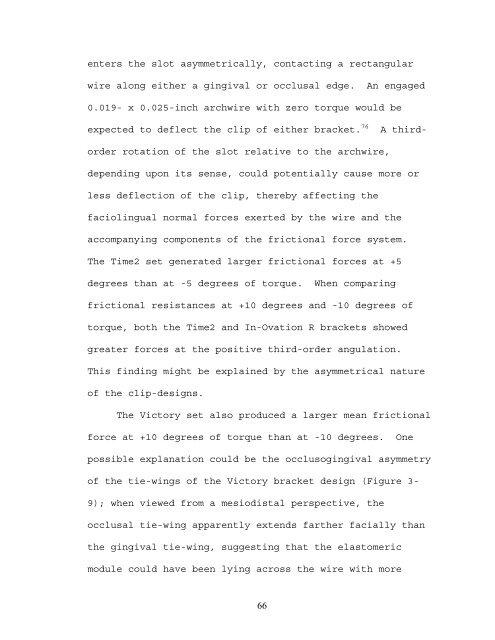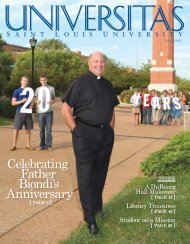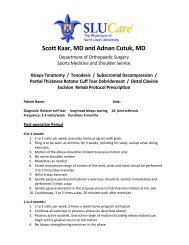The effects of third-order torque and self - Saint Louis University
The effects of third-order torque and self - Saint Louis University
The effects of third-order torque and self - Saint Louis University
Create successful ePaper yourself
Turn your PDF publications into a flip-book with our unique Google optimized e-Paper software.
enters the slot asymmetrically, contacting a rectangular<br />
wire along either a gingival or occlusal edge. An engaged<br />
0.019- x 0.025-inch archwire with zero <strong>torque</strong> would be<br />
expected to deflect the clip <strong>of</strong> either bracket. 76 A <strong>third</strong>-<br />
<strong>order</strong> rotation <strong>of</strong> the slot relative to the archwire,<br />
depending upon its sense, could potentially cause more or<br />
less deflection <strong>of</strong> the clip, thereby affecting the<br />
faciolingual normal forces exerted by the wire <strong>and</strong> the<br />
accompanying components <strong>of</strong> the frictional force system.<br />
<strong>The</strong> Time2 set generated larger frictional forces at +5<br />
degrees than at -5 degrees <strong>of</strong> <strong>torque</strong>. When comparing<br />
frictional resistances at +10 degrees <strong>and</strong> -10 degrees <strong>of</strong><br />
<strong>torque</strong>, both the Time2 <strong>and</strong> In-Ovation R brackets showed<br />
greater forces at the positive <strong>third</strong>-<strong>order</strong> angulation.<br />
This finding might be explained by the asymmetrical nature<br />
<strong>of</strong> the clip-designs.<br />
<strong>The</strong> Victory set also produced a larger mean frictional<br />
force at +10 degrees <strong>of</strong> <strong>torque</strong> than at -10 degrees. One<br />
possible explanation could be the occlusogingival asymmetry<br />
<strong>of</strong> the tie-wings <strong>of</strong> the Victory bracket design (Figure 3-<br />
9); when viewed from a mesiodistal perspective, the<br />
occlusal tie-wing apparently extends farther facially than<br />
the gingival tie-wing, suggesting that the elastomeric<br />
module could have been lying across the wire with more<br />
66
















